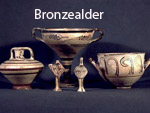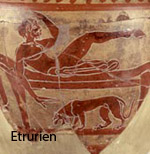Antikmuseet’s collections consist of plaster copies, antiquities, and coins which narrate the history of the Mediterranean countries’ cultures from the Egyptian and Near-Oriental cultures around 3000 BC to the fall of the Roman Empire around 400 AD.
A Short Historical View of the Collections
 | Pharaonic Egypt had a flourishing court art. In the exhibition you can see copies of statues showing the pharaohs Khefren (2520-2494 BC) and Amasis II (570-526 BC) portrayed in virtually the same mode of expression despite the two living two millennia apart. You can also study a real mummy of the Amun singer Ta-bast from around 1000 BC. Her sarcophagus is richly decorated with hieroglyphs and images of the rituals securing her eternal life after death. |
 | Alongside objects from the Stone Age and early Bronze Age in the Near-Orient, objects are exhibited from the Greek Bronze Age showcasing the wealth in Greece, especially on the Cyclades islands in the Aegean Sea. The Minoan palace culture with its capital on Crete dominated from around 2000 to 1550 BC. Afterwards, the Mycenean culture on the Greek mainland took the leading role. This is the culture depicted in Homer’s epic poetry. |
 | The Greek antiquity from the Geometric period around 900 BC to the Hellenistic period ending in 31 BC plays a great part in the museum’s collections. Copies of important sculptures covering the whole period, e.g. from the Acropolis in Athens, and clay jars from the Greek city-states discovered in tombs and shrines throughout the whole Mediterranean narrate the story of art and craftsmanship and its importance to contemporaries and to posterity. |
 | In the Archaic period (approx. 600-480 BC) the Etruscan civilization was the leading culture in Italy. Rome was ruled by Etruscan kings and could almost be considered an Etruscan city. The last Etruscan king was driven away from Rome in 510 BC. A small exhibition narrates the history of Etruscan cities and graves and the rich material relics left behind, e.g. the Etruscan bucchero, imitations of Greek figurative pottery, and bronze objects. |
 | The emperor himself was the focal point in the vast Roman Empire and it was very important that his portrait was spread to even the most distant parts of the realm. The emperor portrait was first and foremost spread via coins and statues of marble or bronze. One example of a marble statue is the important statue of Emperor Augustus discovered in his wife Livia’s villa in Prima Porta. Often portraits only consisted of a bust, several of which are in the museum collection, among them members of the Julio-Claudian dynasty from where the future emperors were recruited. Identification of the sculpture portraits is mostly based on coins. |